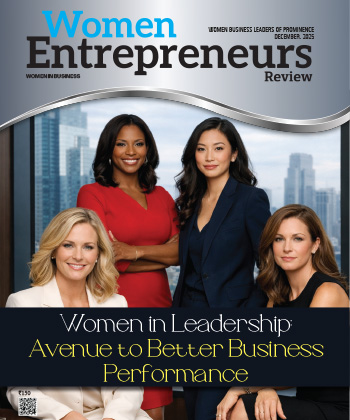
How to Overcome Unseen Biases that Impact Women Leaders' Journeys
By: Shivani Kumar, Executive Director, CII Centre for Women Leadership, Confederation of Indian Industry
Shivani Kumar is a gender inclusion advocate with 20+ years of experience across NGOs, corporates, and development sectors, driving workforce equity through capacity building, advocacy, and grassroots leadership to challenge gender stereotypes and systemic gaps.
In an in-depth interaction with Women Entrepreneurs Review Magazine, Shivani shares her insights on the evolving landscape of women’s inclusion and hidden workplace barriers. She highlights unconventional metrics for measuring leadership potential, and offers an empowering message for women transforming today’s workplaces into inclusive spaces.
How would you describe the evolving landscape of women’s inclusion in formal workplaces today?
The landscape of women’s inclusion in formal workplaces has evolved significantly in recent decades. We at CII, through our initiatives such as Center for Women Leadership and the Indian women network have been working with various ecosystem players towards the entry, retention and growth of women in workplaces.
Through these initiatives and multiple interactions, we have seen a definite evolution of the conversations and actions around women in the workplace. We all know that there is Higher Representation: The formal female Labor Force Participation Rate (FLFPR) in India has seen a notable increase in recent years, with a significant jump from 23.3% in 2017-18 to 41.7% in 2023-24, especially in sectors like tech, manufacturing, healthcare, and education.
This has been supported tremendously by the policy ecosystem. The stress laid by the government on women led development; policies such as the Maternity Benefit Act, initiatives around women safety have all acted as nudges for formal workspaces to take steps in the right direction.
It is also encouraging to see that many companies have moved beyond compliance.
Conversations around gender bias, pay equity, intersectionality, and unconscious bias are more mainstream now, with greater media and institutional support.
Some of the most advanced conversations are intentionally working towards levelling the playing field for men and women, not just through initiatives, but also through the narrative around inclusion.
Which barriers to equality still persist in workplace cultures and societal norms?
While progress is being made, there are often subtle or systemic barriers that are deeply embedded in workplace cultures and societal norms, which continue to hold back the participation of women.
The burden of care (which falls on women) continues to remain a big challenge. The ‘Maternal Penalty’ is prevalent, where women especially mothers are perceived as less committed or competent. Promotions, critical assignments, or leadership tracks often subtly bypass mothers due to assumptions about their availability or ambition.
As smaller sized companies face difficulties in complying with the Maternity Benefit Act, women in these companies are disproportionately affected compared to others.
Those who opt for remote work or flexible hours (often women with caregiving duties) are seen as “less serious” or less promotable. The Flexibility Stigma compounds the maternity penalty, making women seem as “less than ideal” candidates. This added to the stereotypes that continue to persist, subconsciously in many cases around what “leadership” looks like, what jobs can be executed by whom, who is safe, who is not, all unfortunately tilt that balance against women.
Beyond bias and stereotypes, networking gaps often prevent women from building and fast tracking their career trajectories.
What are the most overlooked systemic biases embedded in workplace cultures that subtly limit women’s upward mobility? How can organizations proactively disrupt these patterns?
While explicit discrimination has become less socially acceptable, systemic biases continue to be embedded in workplace norms, leadership expectations, and performance evaluation systems. These biases cumulatively limit and block women’s upward mobility. In addition to the biases already spoken about (in the previous question), following subtle and systemic biases are often overlooked that limit the growth of women in the ecosystem. These biases need to be strategically addressed by the organizations to create an inclusive workplace where women continue to thrive.
Stereotypes such as ‘Leadership traits’ and ‘Masculine jobs’ after often ingrained in our belief system. While certain role involving field work, night shifts and arduous manual labour are perceived as “too masculine”. An “ideal leader" is often subconsciously defined by dominance, assertiveness, and constant availability.
To tackle these biases and break these stereotypes, we need to come up with gender neutral hiring practices and redesign leadership competency frameworks to include empathy, inclusivity, and mentorship.
Belief that promotions and opportunities are purely based on merit overlooks unequal access to visibility, networks, and support. Hence, a structured sponsorship program within organizations should be built where senior leaders actively advocate for high-potential employees, with a keen eye on the number of women employees that are put through the program
Disaggregated data tracking is a must to understand who gets critical assignments disaggregate by gender, race, and background. This will reveal hidden gaps in promotions, attrition, pay etc.
In the current corporate climate, what unconventional metrics or indices should organizations adopt to genuinely measure women’s leadership potential beyond traditional KPIs?
Traditional KPIs like revenue targets, project delivery, or team size are often inadequate and narrow in assessing women’s leadership potential, especially given the systemic biases and unequal access to opportunities that shape how leadership is expressed and evaluated. I also feel that measurement should be done to enable as opposed to evaluate/penalize.
We at CII CWL truly believe that better business happens at inclusive workplaces. Organizations need to adopt unconventional, holistic, and context-sensitive metrics that look at inclusion beyond mere presence of women at various levels.
We have developed the CII CWL Gender Diagnostic tool, which is a self-assessment tool that enables companies to assess how they are doing as relates inclusion, not in isolation, but in relation to business performance, team satisfaction as well as customer relations.
The tool assesses companies based on traditional parameters such as gender parity at workplaces, leadership promotion, care infrastructure, compliance with government policies etc. It also looks at communication within and outside the company, representation of company at various forums, uptake of various programs and policies, performance of teams as relates their leadership.
As companies interested in inclusion might not be at the same place, the assessment helps them understand the stage at which they are in their inclusion journey. This also helps them to chart out an action plan that helps them with entry, retention and growth of women in the ecosystem.
We also have Gender Parity Awards that assess and award companies excelling at driving gender parity. It recognizes companies who treat gender equality as a strategic advantage, who are driven by diverse leadership and inclusive cultures and leaders who influence not only their organizations but also the ecosystem.
In order to enable women leadership, we have to ensure women enter and grow in the workspace. To use measurement to enable the creation of ecosystems where women can enter and then grow to leadership positions.
In addition to the indicators mentioned above, we can also use following measures to gauge the leadership potential of women as there has been evidences that women leaders promote business growth, better inclusive practices, and higher employee retention and satisfaction.
Inclusive Impact Score: It can be used to measure how the leader builds equitable, diverse, and psychologically safe environments. It can also be used to measure diversity and retention rates in their teams, conflict resolution mechanism etc.
Empowerment Multiplier: To gauge how the leader amplifies others' growth and visibility, especially women or overlooked talent. It can also track the number of team members promoted or developed under their leadership.
How can policy frameworks be innovatively designed to promote women’s retention while also creating environments where intersectionality and diverse identities can thrive?
The Indian government has been proactive in creating and designing policy frameworks that enable women’s participation and retention in the economy. HTop of Form
owever, to translate these policies into tangible outcomes, a focus on effective implementation and regular, timely review is essential.
I believe, regular review cycles will help identify gaps, assess the relevance of policies in a dynamic workplace environment, and make necessary adjustments. This iterative process is vital for overcoming barriers to women’s economic participation and aligning policies with evolving societal and economic realities
It is interesting to think how policy design can be used to support the retention and empowerment of diverse women leaders.
I think, policy development should involve diverse women in the co-creation process, moving beyond token consultation to genuine collaboration.
Such an approach will foster a level playing field where both men and women can freely voice their concerns and ideas.
Additionally, policy narratives should shift from being gender-specific to adopting a more neutral tone, with a focus on establishing equitable work environments for everyone. For example, policies around parental leave as opposed to maternal leave, promoting shared responsibilities and reshaping traditional gender roles in the workplace. Creche facilities for all new parents, POSH for all employees, Flexibility and safety provisions for all employees.
LAST WORD: Message For Women Leaders Top of Form
Every decision you make, every time you speak up, mentor, challenge bias, or create space for another voice, you are actively shifting the culture. Your work is not just about creating space for individuals; it’s an opportunity to make your workplace better. It’s a value add to your workspace, not merely a benefit for yourself.
Keep going—not perfectly, but powerfully.
But we have to keep the men in the conversation as well. So, to all the young men- Don’t be apologetic about taking leave to care for your child. Embrace this role with pride; your presence and support are vital, and challenging outdated norms only make us stronger together.
Together, we are creating a future rooted in equity, compassion, and strength. Keep going, you are making a difference.
Most Viewed
- 1 Women's Health Startup HerMD Closing Doors Amid Industry Challenges
- 2 5 Famous Women in Indian Armed Forces
- 3 Saudi Women No longer Require Male Permission for Clothing Choices, says Prince MbS
- 4 Kolkata Medtech Startup Innovodigm Raises Rs 5.5 Crore Seed Funding Led by IAN Group
- 5 Yamunanagar's Kashish Kalra Honoured after Securing 111th Rank in UPSC Civil Services Exam
- 6 Madurai Appoints Its First Woman Corporation Head
- 7 IAS Vijayalakshmi Bidari Appointed as the new Nagpur Divisional Commissioner
- 8 American Entrepreneur Lucy Guo Overtakes T Swift to become Youngest Female Billionaire
- 9 ICC Women's World Cup 2025 Trophy Showcased at Indore's Holkar Stadium
- 10 Aparna Saxena's Beauty Venture AntiNorm Launches in India
- 11 Vidya Nataraj Co-Founded BlueStone Jewellery & Lifestyle files IPO
- 12 5 Women Freedom Fighters of India
- 13 Dr. G Krishnapriya appointed as CEO for Trichy
- 14 M3M & Sirona Partner to Introduce Menstrual Hygiene Vending Machines in 15 Locations
- 15 Punjab Govt launches SHE Cohort 3.0 Supporting Tech-led Women Startups
- 16 Indian origin Lawyer, Sweena Pannu appointed as the US New Superior Court Judge
- 17 The Aurora Tech Award recognizes 4 Indian Women-led Startups
- 18 Kerala's Republic Day parade featured an all-female tableau
- 19 Manisha Kabbur Becomes Karnataka's First Woman International Karate Coach
- 20 Director K. S. Ravikumar's Daughter Maalica Ravikumar Launches Life Coaching Company 'Evergrowth Academy' for Women
- 21 Leezu's Raises Pre-Seed Funding to Accelerate Growth in Sexual Wellness Industry
- 22 Sattu: Super-easy summer drink for PCOS gut healing
- 23 Swathi Nelabhatla creates Sitha App, India's First Women-Exclusive Gig Platform
- 24 7 Timeless Female Kathak Dancers & their Iconic Legacies
- 25 Meet 7 Iconic Women Architects of Modern India & their Most Impactful Work
- 26 This Woman-led Insuretech Startup is Helping Bridge the Education Financing Gap in India
- 27 Women Leaders Share Lessons Learnt from India Women's WC Win
- 28 5 Enterprising Women Founders Powering Singapore's Tech & Innovation Landscape
- 29 4 Women. 4 Stories. One Vision for Smarter, Stronger Healthcare
- 30 Global Gender Gap Narrows to 68.8%, But Full Equality 123 Years Away: WEF Report 2025
- 31 Changemakers: 7 Women Entrepreneurs Taking the Make in India Movement Forward
- 32 Meet Lucy Guo, The Youngest Self-Made Female Billionaire Disrupting Tech
- 33 How Women are Driving India's Festive Online Shopping Surge






